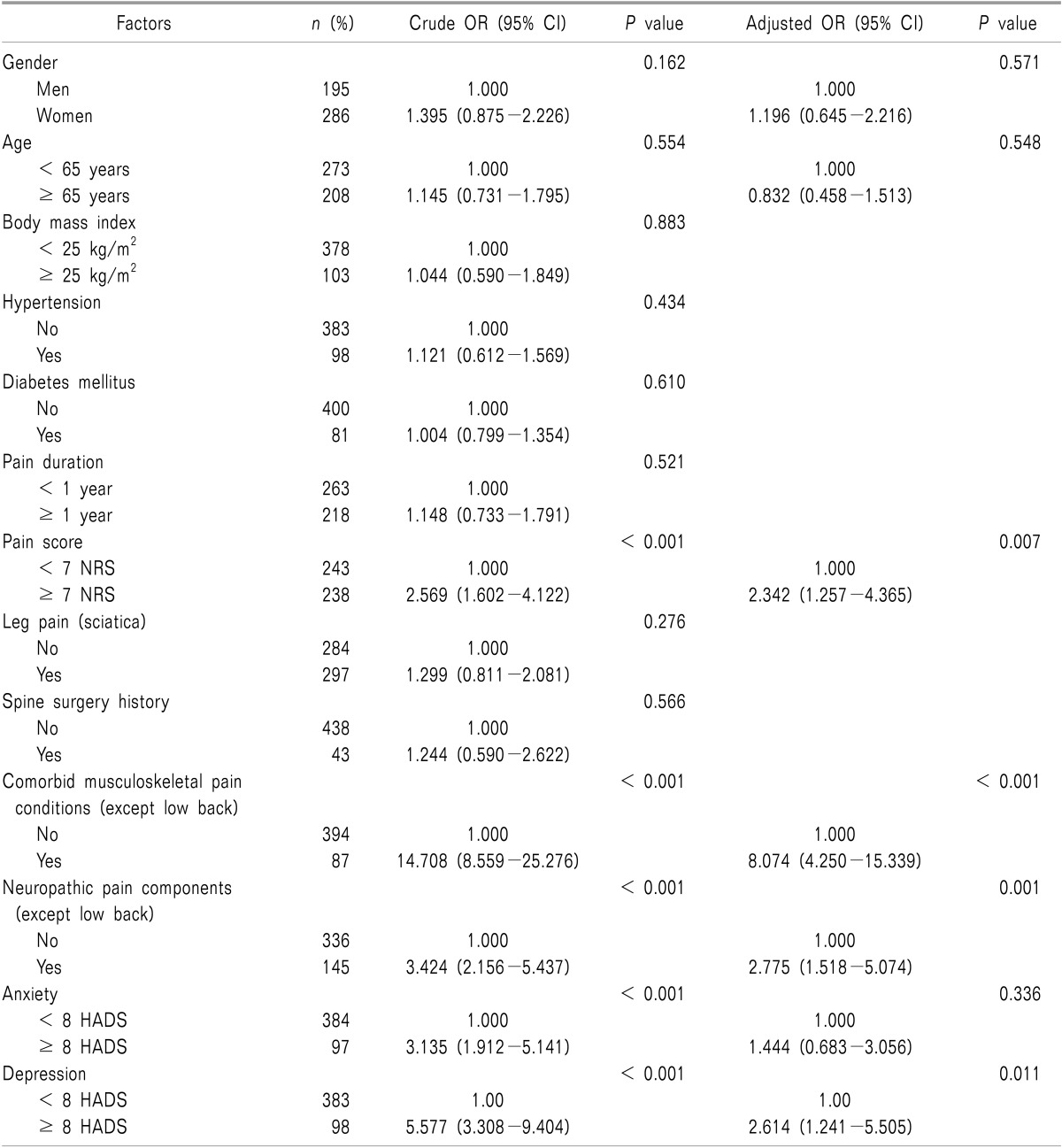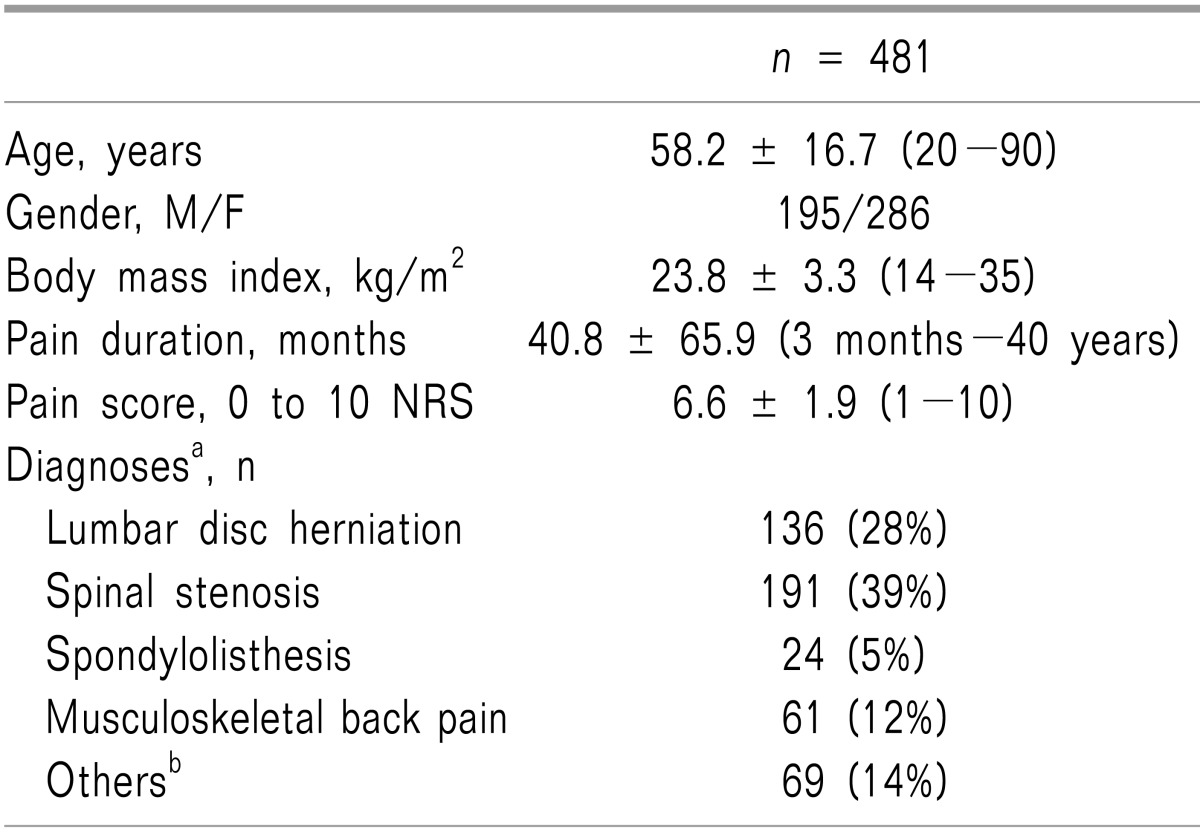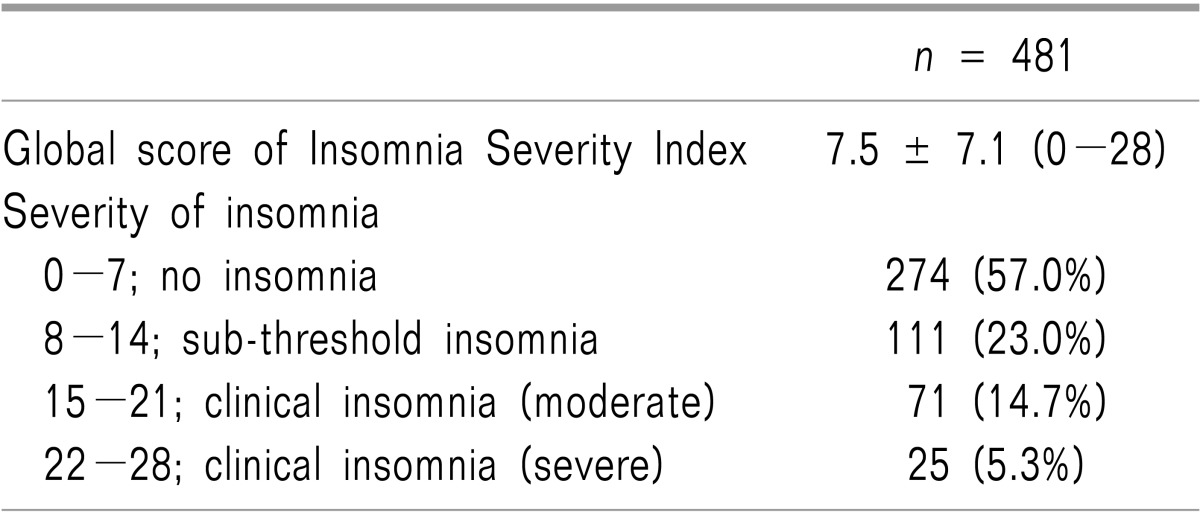1. Gore M, Sadosky A, Stacey BR, Tai KS, Leslie D. The burden of chronic low back pain: clinical comorbidities, treatment patterns, and health care costs in usual care settings. Spine (Phila Pa 1976). 2012; 37:E668–E677. PMID:
22146287.
2. Kelly GA, Blake C, Power CK, O'Keeffe D, Fullen BM. The association between chronic low back pain and sleep: a systematic review. Clin J Pain. 2011; 27:169–181. PMID:
20842008.
3. Bahouq H, Allali F, Rkain H, Hmamouchi I, Hajjaj-Hassouni N. Prevalence and severity of insomnia in chronic low back pain patients. Rheumatol Int. 2013; 33:1277–1281. PMID:
23124732.

4. Tang NK, Wright KJ, Salkovskis PM. Prevalence and correlates of clinical insomnia co-occurring with chronic back pain. J Sleep Res. 2007; 16:85–95. PMID:
17309767.

5. Marin R, Cyhan T, Miklos W. Sleep disturbance in patients with chronic low back pain. Am J Phys Med Rehabil. 2006; 85:430–435. PMID:
16628150.

6. Roth T. Insomnia: definition, prevalence, etiology, and consequences. J Clin Sleep Med. 2007; 3:S7–S10. PMID:
17824495.

7. van de Water AT, Eadie J, Hurley DA. Investigation of sleep disturbance in chronic low back pain: an age- and gender-matched case-control study over a 7-night period. Man Ther. 2011; 16:550–556. PMID:
21652257.

8. Park EJ, Lee SJ, Koh DY, Han YM. Repetitive transcranial magnetic stimulation to treat depression and insomnia with chronic low back pain. Korean J Pain. 2014; 27:285–289. PMID:
25031816.

9. Bastien CH, Vallières A, Morin CM. Validation of the Insomnia Severity Index as an outcome measure for insomnia research. Sleep Med. 2001; 2:297–307. PMID:
11438246.

10. Cho YW, Song ML, Morin CM. Validation of a Korean version of the insomnia severity index. J Clin Neurol. 2014; 10:210–215. PMID:
25045373.

11. Bjelland I, Dahl AA, Haug TT, Neckelmann D. The validity of the Hospital Anxiety and Depression Scale. An updated literature review. J Psychosom Res. 2002; 52:69–77. PMID:
11832252.
12. Nomura K, Yamaoka K, Nakao M, Yano E. Impact of insomnia on individual health dissatisfaction in Japan, South Korea, and Taiwan. Sleep. 2005; 28:1328–1332. PMID:
16295219.

13. Lobbezoo F, Visscher CM, Naeije M. Impaired health status, sleep disorders, and pain in the craniomandibular and cervical spinal regions. Eur J Pain. 2004; 8:23–30. PMID:
14690671.

14. Cho CH, Jung SW, Park JY, Song KS, Yu KI. Is shoulder pain for three months or longer correlated with depression, anxiety, and sleep disturbance. J Shoulder Elbow Surg. 2013; 22:222–228. PMID:
22738644.

15. Murphy SL, Lyden AK, Phillips K, Clauw DJ, Williams DA. Association between pain, radiographic severity, and centrally-mediated symptoms in women with knee osteoarthritis. Arthritis Care Res (Hoboken). 2011; 63:1543–1549. PMID:
22034116.

16. Björnsdóttir SV, Jónsson SH, Valdimarsdóttir UA. Mental health indicators and quality of life among individuals with musculoskeletal chronic pain: a nationwide study in Iceland. Scand J Rheumatol. 2014; 43:419–423. PMID:
24814312.

17. Haukka E, Kaila-Kangas L, Ojajärvi A, Miranda H, Karppinen J, Viikari-Juntura E, et al. Pain in multiple sites and sickness absence trajectories: a prospective study among Finns. Pain. 2013; 154:306–312. PMID:
23245998.

18. Rohrbeck J, Jordan K, Croft P. The frequency and characteristics of chronic widespread pain in general practice: a case-control study. Br J Gen Pract. 2007; 57:109–115. PMID:
17263927.
19. O'Brien EM, Waxenberg LB, Atchison JW, Gremillion HA, Staud RM, McCrae CS, et al. Intraindividual variability in daily sleep and pain ratings among chronic pain patients: bidirectional association and the role of negative mood. Clin J Pain. 2011; 27:425–433. PMID:
21415723.
20. Narita M, Niikura K, Nanjo-Niikura K, Narita M, Furuya M, Yamashita A, et al. Sleep disturbances in a neuropathic pain-like condition in the mouse are associated with altered GABAergic transmission in the cingulate cortex. Pain. 2011; 152:1358–1372. PMID:
21396773.

21. Yamashita A, Hamada A, Suhara Y, Kawabe R, Yanase M, Kuzumaki N, et al. Astrocytic activation in the anterior cingulate cortex is critical for sleep disorder under neuropathic pain. Synapse. 2014; 68:235–247. PMID:
24488840.

22. Ford DE, Kamerow DB. Epidemiologic study of sleep disturbances and psychiatric disorders. An opportunity for prevention. JAMA. 1989; 262:1479–1484. PMID:
2769898.

23. Artner J, Lattig F, Cakir B, Gündel H, Reichel H, Spiekermann JA. Prevalence of mental disorders in multimodal therapy of chronic back pain. Orthopade. 2012; 41:950–957. PMID:
23149491.
24. Chiu YH, Silman AJ, Macfarlane GJ, Ray D, Gupta A, Dickens C, et al. Poor sleep and depression are independently associated with a reduced pain threshold. Results of a population based study. Pain. 2005; 115:316–321. PMID:
15911158.

25. O'Donoghue GM, Fox N, Heneghan C, Hurley DA. Objective and subjective assessment of sleep in chronic low back pain patients compared with healthy age and gender matched controls: a pilot study. BMC Musculoskelet Disord. 2009; 10:122. PMID:
19799778.





 PDF
PDF Citation
Citation Print
Print




 XML Download
XML Download